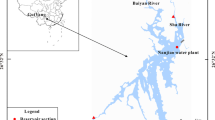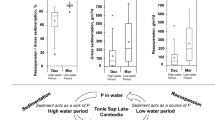Abstract
To understand aquatic environmental deterioration due to the anoxic state in an organically polluted water body, water quality dynamics under anaerobic conditions were examined through beaker-scale water quality monitoring. This study focused on the dynamic properties of NO3–N, NH4–N, PO4–P, and sulfide from the biochemical reactions point of view, and based on anaerobic respiration activities, such as denitrification, iron reduction, and sulfate reduction. The specific aims of this study were to quantitatively estimate the impacts of the oxidative/reductive state of the sediment surface and the high/low concentrations of dissolved organic matter on the dynamic properties of water quality under anaerobic conditions. The beaker-scale water quality monitoring was carried out through continuous measurements of dissolved oxygen and oxidation–reduction potential (ORP), as well as periodic observations of water quality parameters for six cases that are composed from combinations of three experimental conditions: (1) concentration of dissolved organic carbon (DOC); (2) redox state of the sediment; and (3) concentration of NO3–N. As a result, the temporal changes in ORP under anaerobic conditions exhibited a five-step process of decline without these conditions. Also, high DOC concentrations and oxidative states of the bottom mud accelerated the release of PO4–P and sulfide generation through promoting biological iron reduction and sulfate reduction, because these conditions increase respiratory substrates for anaerobic microorganisms, such as iron and sulfate-reducing bacteria. It was concluded that our results would provide important information about the mechanisms of aqueous environmental deterioration due to organic pollution in closed water bodies.












Similar content being viewed by others
References
DiChristina TJ (1992) Effects of nitrate and nitrite on dissimilatory iron reduction by Shewanella putrefaciens 200. J Bacteriol 174:1891–1896
Do NT, Yoshimura Y, Harada M, Hiramatsu K (2015) Generation of hydrogen sulfide in the deepest part of a reservoir under anoxic water conditions. Paddy Water Environ. doi:10.1007/s10333-013-0412-0
Ellis-Evans JC, Lemon ECG (1989) Some aspects of iron cycling in maritime Antarctic lakes. Hydrobiologia 172:149–164. doi:10.1007/BF00031618
Gordon J, Higgins J (2007) Fundamental water quality processes. In: Martin J, Edinger J, Higgins J, Gorden J (eds) Energy production and reservoir water quality. Am Soc Civ Eng, Reston, pp 3.1–3.29
Hadas O, Pinkas R (1995) Sulfate reduction processes in sediments at different sites in Lake Kinneret, Israel. Microb Ecol An Int J 30:55–66. doi:10.1007/BF00184513
Harada M, Hiramatsu K, Saitoh T, Mori M, Marui A (2009) Dynamics of water qualities in a eutrophic water body under scarce underwater light environment. J Rainwater Catchment Syst 14:87–96 (in Japanese)
Harada M, Hiramatsu K, Fukuda S (2014) Dynamics of water qualities under the anaerobic and reductive state in an organically polluted closed water body. J Rainwater Catchment Syst 20(1):49–55 (in Japanese with English abstract)
Henneberry YK, Kraus TEC, Nico PS, Horwath WR (2012) Structural stability of coprecipitated natural organic matter and ferric iron under reducing conditions. Org Geochem 48:81–89. doi:10.1016/j.orggeochem.2012.04.005
Krevš A, Kučinskienė A (2009) Microbial mineralization of organic matter in bottom sediments of small anthropogenised lakes. Ekologija 55:127–132. doi:10.2478/v10055-009-0016-6
Li Z, Sheng Y, Yang J, Burton ED (2016) Phosphorus release from coastal sediments: impacts of the oxidation–reduction potential and sulfide. Mar Pollut Bull 113:176–181. doi:10.1016/j.marpolbul.2016.09.007
Lijklema L (1980) Interaction of orthophosphate with iron (III) and aluminum hydroxides. Environ Sci Technol 14:537–541. doi:10.1021/es60165a013
Lovley DR (1991) Dissimilatory Fe(III) and Mn(IV) reduction. Microbiol Rev 55:259–287
Melton ED, Schmidt C, Kappler A (2012) Microbial iron (II) oxidation in littoral freshwater lake sediment: the potential for competition between phototrophic versus nitrate-reducing iron (II)-oxidizers. Front Microbiol 3:1–12. doi:10.3389/fmicb.2012.00197
Müller S, Mitrovic SM, Baldwin DS (2016) Oxygen and dissolved organic carbon control release of N, P and Fe from the sediments of a shallow, polymictic lake. J Soils Sediments 16:1109–1120. doi:10.1007/s11368-015-1298-9
Nedwell DB (1984) The input and mineralization of organic carbon in anaerobic sediments. Adv Microb Ecol 7:93–131
Nishioka T, Harada M, Hiramatsu K, Tabata T (2016) Experimental study on dynamics of water qualities under the an-aerobic state in an organically polluted water body. J Rainwater Catchment Syst 21(2):13–21 (in Japanese with English abstract)
Omoregie EO, Couture RM, Van Cappellen P et al (2013) Arsenic bioremediation by biogenic iron oxides and sulfides. Appl Environ Microbiol 79:4325–4335. doi:10.1128/AEM.00683-13
Oniki A, Harada M, Hiramatsu K, Tabata T (2017) Experimental study on dynamics of water qualities near bed material in anoxic water area focused on nitrate nitrogen. J Rainwater Catchment Syst 22(2):31–39 (in Japanese with English abstract)
Polubesova T, Chefetz B (2014) DOM-affected transformation of contaminants on mineral surfaces: a review. Crit Rev Environ Sci Technol 44:223–254. doi:10.1080/10643389.2012.710455
Roden EE, Edmonds JW (1997) Phosphate mobilization in iron-rich anaerobic sediments: microbial Fe(III) oxide reduction versus iron-sulfide formation. Arch Fur Hydrobiol 139:347–378
Sakai S, Nakaya M, Sampei Y et al (2013) Hydrogen sulfide and organic carbon at the sediment-water interface in coastal brackish Lake Nakaumi, SW Japan. Environ Earth Sci 68:1999–2006. doi:10.1007/s12665-012-1887-5
Sørensen J, Jørgensen BB, Revsbech NP (1979) A comparison of oxygen, nitrate, and sulfate respiration in coastal marine sediments. Microb Ecol 5:105–115. doi:10.1007/BF02010501
Whitmire SL, Hamilton SK (2005) Rapid removal of nitrate and sulfate in freshwater wetland sediments. J Environ Qual 34:2062–2071. doi:10.2134/jeq2004.0483
Acknowledgements
The authors greatly appreciate the support under FY2015-2017 JSPS Grants-in-Aid for Scientific Research (C) (Project number: 15K07649) and FY2016-2018 JSPS Grant-in-Aid for Exploratory Research (Project number: 16K15009).
Author information
Authors and Affiliations
Corresponding author
Rights and permissions
About this article
Cite this article
Thach, T.T., Harada, M., Oniki, A. et al. Experimental study on the influence of dissolved organic matter in water and redox state of bottom sediment on water quality dynamics under anaerobic conditions in an organically polluted water body. Paddy Water Environ 15, 889–906 (2017). https://doi.org/10.1007/s10333-017-0600-4
Received:
Revised:
Accepted:
Published:
Issue Date:
DOI: https://doi.org/10.1007/s10333-017-0600-4




